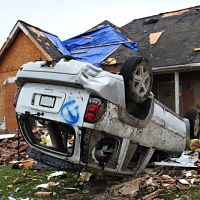
 |
|
 |
Interim Facility Hopefully Operational in Fall The Americus Times-Recorder recently interviewed Sumter Regional President and CEO David Seagraves as to the future of the hospital, both in terms of an interim facility and a permanent facility. He said although it may be difficult for those outside the organization to see it that progress is being made in the building of an interim facility — which the organization hopes to have operational in early fall, he added — and a permanent facility. However, Seagraves and other hospital officials seem to remain confident about one thing: The process will be a lengthy one. “Well, it depends on how well the interim facility is accepted by the community,” Seagraves said, when asked how long the hospital could continue to meet payroll. “We plan on building an interim hospital facility, which ... will provide significant assistance to the organization in continuing to meet payroll, and provide an additional source of revenue in addition to the Business Interruption coverage.” He added there are approximately 700 employees on the hospital's payroll. Seagraves said representatives from CHUBB came down last week and presented their initial figures, “the information they had initially gotten from their construction consultants. “They indicated to us that figure, $39,500,000, for repairs was basically incomplete, because they still have to go through the analysis of the costs associated with building code upgrades that would most likely be involved, given the extent of the damage to the hospital.” Seagraves added, “When the repair costs exceeds 50 percent of the replacement costs, then it's considered new construction. When you're dealing with new construction, you've got to comply with current building codes. The president and CEO added that in 2006, building codes changed “a good bit,” as they related to hospitals. “So, if it's considered new construction, then we would have to adopt all ... those changes, and they might be very, very expensive to do,” Seagraves said. “So, they are working up the figure associated with that portion of the estimate, and we hope to have that at the end of next week.” Now, Seagraves explained that the Americus-based Hooks Agency is the broker for CHUBB, the insurance agency handling all the property coverage. “The next step is building the replacement facility and we don't know how much that will cost at this point, because we are not far enough into the planning phase of that to know exactly how many square feet will be included and exactly what we would have to use and how many rooms,” he said. “It's too early in the process.” Seagraves said that the firm of Price Waterhouse Cooper is the construction planning consulting firm, and some of the company's representatives have met with “the committee” to get the planning process for the permanent facility started. “We've been obtaining information from the various departments, in determining their needs,” Seagraves said. He added this information includes their critical link in the new organization, what kind of equipment they need; how many rooms are needed, what are their function, what kind of equipment goes in the rooms and how many square feet the rooms need to be. Seagraves said once that is determined, Price Waterhouse Cooper will go to the architectural firm for the design, and then a price tag will be put on the design. When it met at last week's administrative briefing, the Americus Mayor and Council voted to close the portion East Jefferson Street between Mayo Street and Hudson Street, so the hospital could begin constructing it's interim facility. Seagraves explained this will be the “staging area” for the crews with the large trucks and big equipment and the hospital asked the city to close the street for public safety reasons. At the meeting, CAO Charlotte Cotton said business owners would still be able to come and go, but the street needed to be closed to both driver and pedestrian traffic. |
|
||||||||
| Phoebe Sumter Medical Center, 126 Hwy. 280 West, Americus, GA 31719 (229) 924-6011 | ||||||||||
| ©2025 FastHealth Corporation Terms Privacy | US Patent Numbers 7,720,998 B2, 7,836,207 |